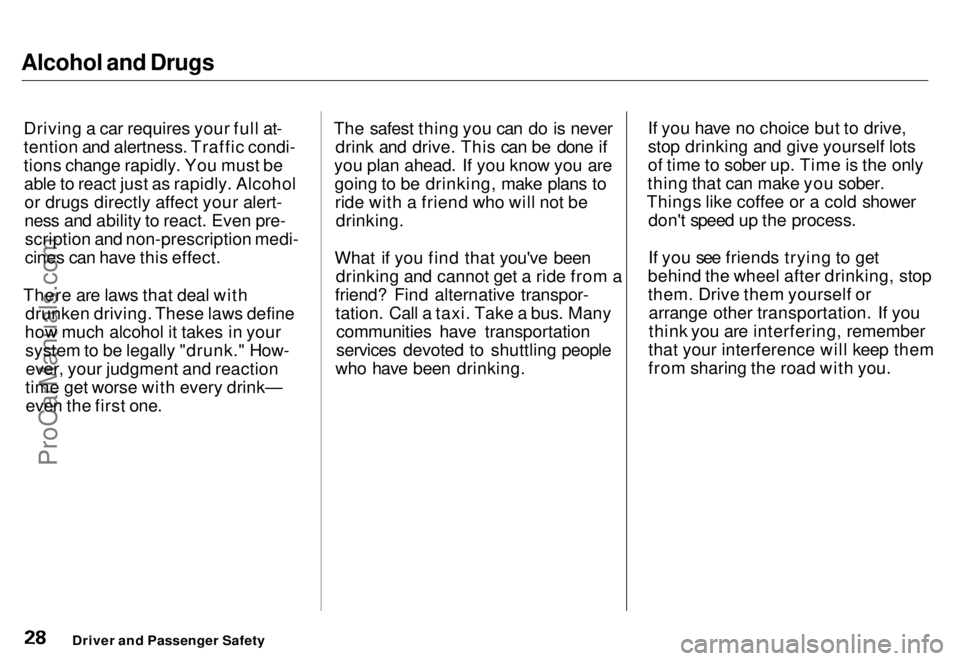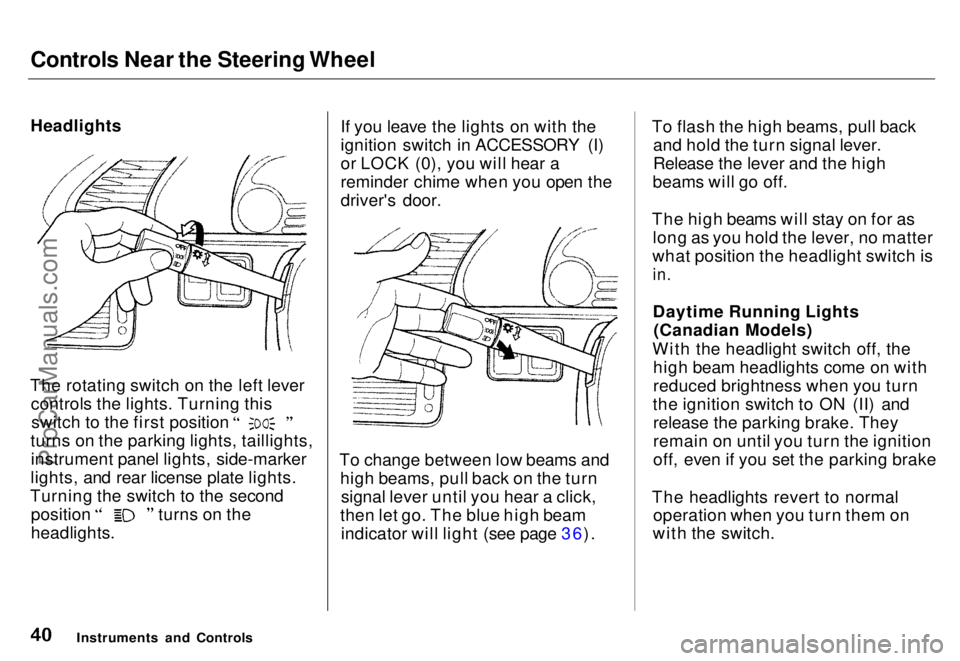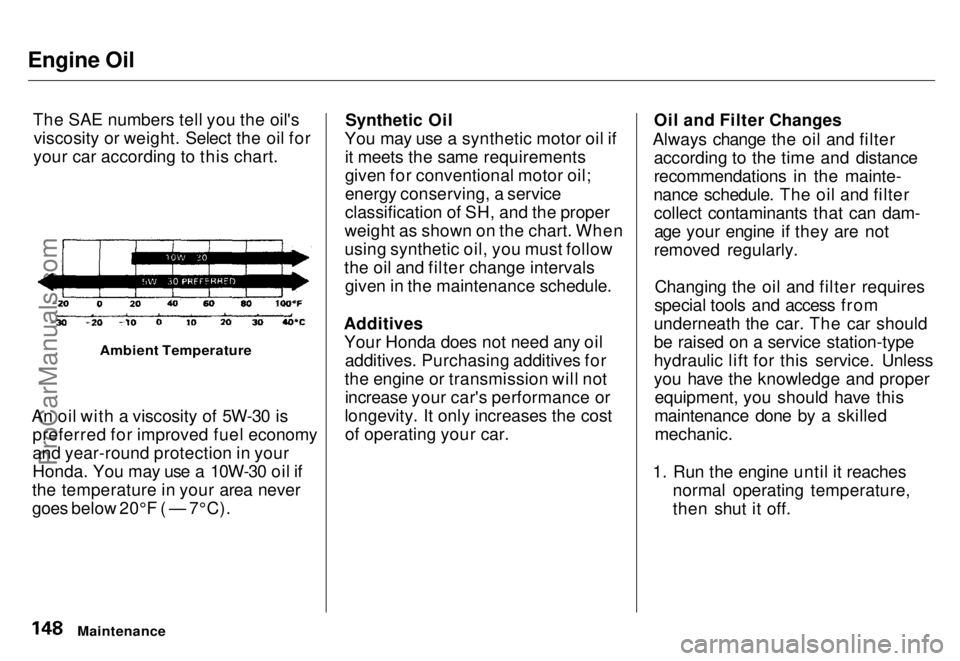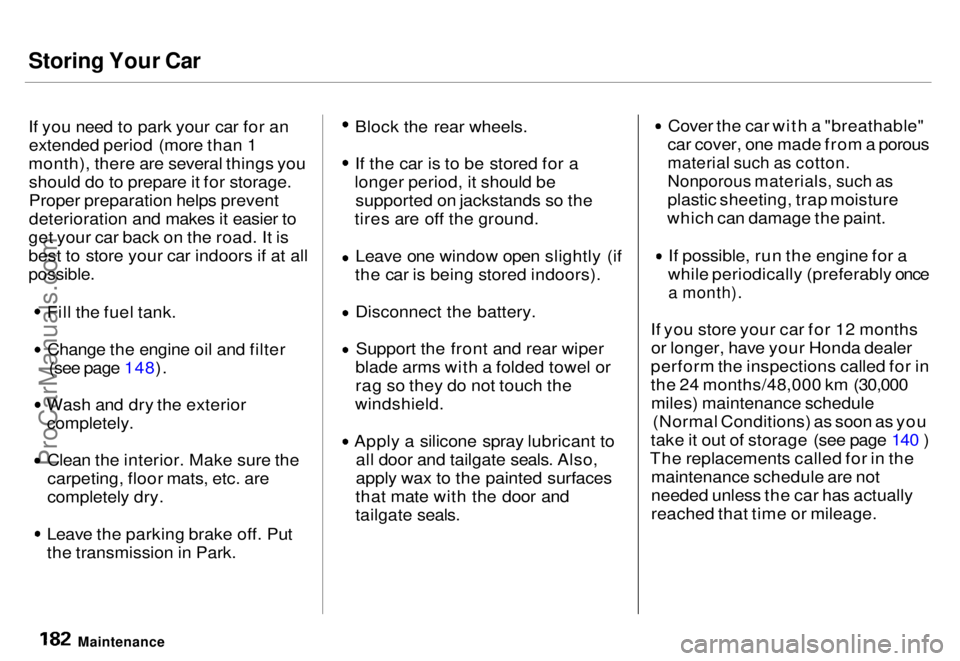1996 HONDA ODYSSEY change time
[x] Cancel search: change timePage 29 of 240

Alcohol and Drugs
Driving a car requires your full at-
tention and alertness. Traffic condi-
tions change rapidly. You must beable to react just as rapidly. Alcoholor drugs directly affect your alert-
ness and ability to react. Even pre-scription and non-prescription medi-
cines can have this effect.
There are laws that deal with drunken driving. These laws define
how much alcohol it takes in your system to be legally "drunk." How-ever, your judgment and reaction
time get worse with every drink— even the first one. The safest thing you can do is never
drink and drive. This can be done if
you plan ahead. If you know you are going to be drinking, make plans toride with a friend who will not be drinking.
What if you find that you've been drinking and cannot get a ride from a
friend? Find alternative transpor- tation. Call a taxi. Take a bus. Many communities have transportation
services devoted to shuttling people
who have been drinking. If you have no choice but to drive,
stop drinking and give yourself lots
of time to sober up. Time is the only
thing that can make you sober.
Things like coffee or a cold shower don't speed up the process.
If you see friends trying to get
behind the wheel after drinking, stop
them. Drive them yourself or arrange other transportation. If you
think you are interfering, remember
that your interference will keep them
from sharing the road with you.
Driver and Passenger SafetyProCarManuals.comMain Menu s t Table of Contents
Page 36 of 240

Indicator Lights
U.S.
Anti-lock Brake System
(ABS) Indicator
Canada
Only on cars equipped with ABS (see
page 125)
This light normally comes on when you turn the ignition ON (II) andgoes off after the engine starts. If itcomes on at any other time, there is
a problem in the ABS. If this happens,
take the car to your dealer to have it checked. With the light on, your car
still has normal braking ability but no
anti-lock.
Turn Signal and
Hazard WarningIndicators
The left or right turn signal light
blinks when you signal a lane change
or turn. If the light does not blink or
blinks rapidly, it usually means one
of the turn signal bulbs is burned out (see page 178). Replace the bulb as
soon as possible, since other drivers
cannot see that you are signalling.
When you turn on the Hazard
Warning switch, both turn signal lights blink. All turn signals on theoutside of the car should flash. Door and Brake Lamp Monitor
The appropriate light comes on in this display if the tailgate or any dooris not closed tightly. If a brake lightdoes not work, the BRAKE LAMP
indicator comes on when you push
the brake pedal with the ignition switch ON (II).
A burned out brake light is a hazard when drivers behind you cannot tell
you are braking. Have your brake lights repaired right away.
All the lights in the monitor display come on for a few seconds when you
turn the ignition switch ON (II).
Instruments and Controls
ABSProCarManuals.comMain Menu s t Table of Contents
Page 41 of 240

Controls Near the Steering Wheel
Headlights
The rotating switch on the left lever controls the lights. Turning this switch to the first position
turns on the parking lights, taillights, instrument panel lights, side-marker
lights, and rear license plate lights.
Turning the switch to the second position turns on the
headlights. If you leave the lights on with the
ignition switch in ACCESSORY (I)
or LOCK (0), you will hear a
reminder chime when you open the
driver's door.
To change between low beams and high beams, pull back on the turnsignal lever until you hear a click,
then let go. The blue high beam indicator will light (see page 36). To flash the high beams, pull back
and hold the turn signal lever.
Release the lever and the high
beams will go off.
The high beams will stay on for as long as you hold the lever, no matter
what position the headlight switch is
in.
Daytime Running Lights (Canadian Models)
With the headlight switch off, the high beam headlights come on with
reduced brightness when you turn
the ignition switch to ON (II) and release the parking brake. They
remain on until you turn the ignition
off, even if you set the parking brake
The headlights revert to normal operation when you turn them on
with the switch.
Instruments and ControlsProCarManuals.comMain Menu s t Table of Contents
Page 147 of 240

Engine Oil
The SAE numbers tell you the oil'sviscosity or weight. Select the oil for
your car according to this chart.
Ambient Temperature
An oil with a viscosity of 5W-30 is preferred for improved fuel economy
and year-round protection in your
Honda. You may use a 10W-30 oil if
the temperature in your area never
goes below 20°F ( — 7°C).
Synthetic Oil
You may use a synthetic motor oil if it meets the same requirements
given for conventional motor oil;
energy conserving, a service
classification of SH, and the proper
weight as shown on the chart. When
using synthetic oil, you must follow
the oil and filter change intervals given in the maintenance schedule.
Additives Your Honda does not need any oil additives. Purchasing additives for
the engine or transmission will not increase your car's performance or
longevity. It only increases the cost of operating your car. Oil and Filter Changes
Always change the oil and filter according to the time and distance
recommendations in the mainte-
nance schedule. The oil and filter collect contaminants that can dam-age your engine if they are not
removed regularly.
Changing the oil and filter requires
special tools and access from
underneath the car. The car should
be raised on a service station-type
hydraulic lift for this service. Unless
you have the knowledge and proper equipment, you should have this
maintenance done by a skilled
mechanic.
1. Run the engine until it reaches normal operating temperature,
then shut it off.
MaintenanceProCarManuals.comMain Menu s t Table of Contents
Page 181 of 240

Storing Your Car
If you need to park your car for an
extended period (more than 1
month), there are several things you should do to prepare it for storage.
Proper preparation helps prevent
deterioration and makes it easier to
get your car back on the road. It is
best to store your car indoors if at all
possible.
Fill the fuel tank.
Change the engine oil and filter
(see page 148). Wash and dry the exterior
completely.
Clean the interior. Make sure the
carpeting, floor mats, etc. are
completely dry.
Leave the parking brake off. Put
the transmission in Park. Block the rear wheels.
If the car is to be stored for a
longer period, it should be supported on jackstands so the
tires are off the ground.
Leave one window open slightly (if
the car is being stored indoors).
Disconnect the battery.Support the front and rear wiper
blade arms with a folded towel or
rag so they do not touch the
windshield. Apply a silicone spray lubricant to
all door and tailgate seals. Also,
apply wax to the painted surfaces
that mate with the door and
tailgate seals. Cover the car with a "breathable"
car cover, one made from a porous
material such as cotton.
Nonporous materials, such as
plastic sheeting, trap moisture
which can damage the paint. If possible, run the engine for a
while periodically (preferably once
a month).
If you store your car for 12 months or longer, have your Honda dealer
perform the inspections called for in
the 24 months/48,000 km (30,000 miles) maintenance schedule (Normal Conditions) as soon as you
take it out of storage (see page 140 )
The replacements called for in the maintenance schedule are not
needed unless the car has actually
reached that time or mileage.
MaintenanceProCarManuals.comMain Menu s t Table of Contents
Page 238 of 240

Index
Seats
Reclining the Second Seat.......... 59
Removing the Second Seats....... 57
Third Seat Access...................... 56
Serial Number................................ 216
Service Intervals*.......................... 140
Service Manual.............................. 233
Service Station Procedures.......... 110
Setting the Clock............................. 66
Shifting the Automatic
Transmission.............................. 120
Shift Lever Position Indicator...... 120
Side Marker Lights, Bulb
Replacement in.......................... 178
Signaling Turns................................ 41
Snow Tires...................................... 174
Solvent-type Cleaners.................... 184
Sound System................................... 83
Spare Tire
Inflating....................................... 192
Specifications............................. 219
Spark Plugs, Replacing................. 160
Specifications Charts..................... 218
Speed Control...................................
46
Speedometer.................................... 3 7
SR
S Indicator............................. 16,
34
START (Ignitio
n
Key Position)..... 50
Starting the Engine........................ 119 In Cold Weather at HighAltitude................................... 119
With a Dead Battery................. 200
Steam Coming from Engine......... 202
Steering Wheel
Adjustment................................... 44
Anti-theft Column Lock.............. 49
Stereo Sound System...................... 83 Storing Your Car............................ 182
Sunroof............................................. 63
Closing Manually....................... 207
Operation......................................
63
Supplemental Restrain t
System
Service Precautions..................... 17
Servicing....................................... 16
SRS Indicator.......................... 16, 34
System
Components................... .
12
Synthetic Oil................................... 148
Tailgate........................................... 52
Taillights, Changing Bulbs in....... 179
Taking Care of the Unexpected.. 191 Tape Player................................ 87, 99
Technical Descriptions Anti-lock Brake System............ 220Emission Control Systems........ 224
Three Way Catalytic
Converter................................ 226
Tire Information........................
221
Temperature Gauge....................... .
38
Tether Attachment Points.............. 26 Three Way Catalytic Converter... 226
Time, Setting the...........................
66
Tire Chains.................................... .
174
Tire, How to Change a Flat.......... 193
Tires................................................ 169 Air Pressure............................... 170
Checking Wear.......................... 171
Compact Spare........................... 192
DOT Tire Quality Grading....... 222
Inflation....................................... 170
CONTINUED
ProCarManuals.comMain Menu s t